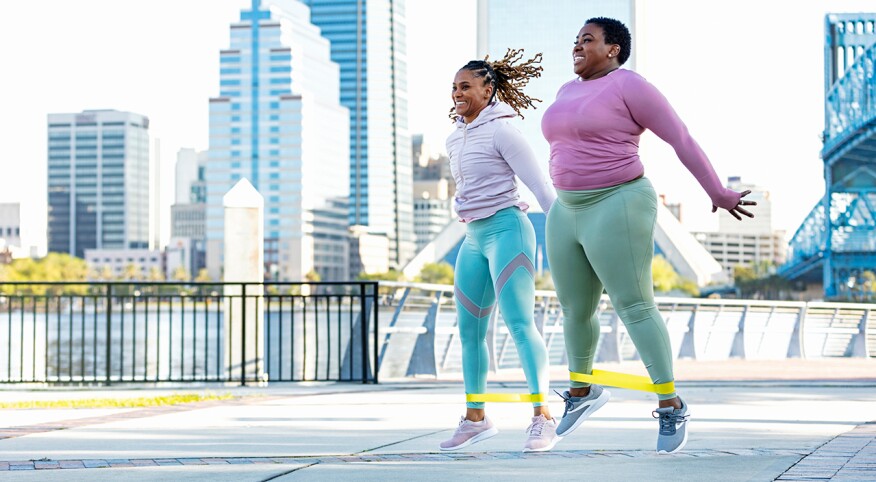When was the last time you busted out a good ol’ round of jumping jacks? If it’s been a while, it might be time to add this move to your daily repertoire.
Now, if you’re already saying no because jumping leads to certain unwanted issues (ahem, a little urine trickle), we understand. Don’t worry, Sis; modified jacks shouldn’t cause those problems. Emptying your bladder before you start your jumping jacks also helps.
As always, check with your doctor before beginning any new exercise program. That’s especially important if you have osteoporosis, as high-impact activities can lead to fractures and weakened bones. (But keep reading. We've included low-impact moves that are friendly to most bodies.)
This modified jumping jack is low-impact and great for beginners, people with joint replacements, or those with knee, hip or ankle problems.
With that out the way, here are the many benefits of jumping jacks.
- They’re a fat-burning, full-body-sculpting exercise. When we say this move hits the spot, we mean every spot. Jumping jacks work your entire body, including your arms, shoulders, legs, core, hips and glutes, says Flo Elkins, a certified personal trainer and owner of F.L.O. Life Fitness in Los Angeles.
- They torch calories. Jumping jacks are high-intensity, so they boost your metabolism and help burn calories, Elkins says. According to MyFitnessPal, a 155-pound person can burn about 97 calories in 10 minutes of vigorous jumping jacks (yes, it’s OK to break it up into spurts). That’s a few calories more than if that same person had run for 10 minutes at a 5-mph pace.
- You’ll preserve bone density. As we get older, our bone density naturally decreases, which puts us at risk for osteoporosis. Since jumping jacks are a weight-bearing exercise (due to the impact when your feet touch the ground), they help strengthen your bones.
- They keep your heart strong. “Jumping jacks are an aerobic exercise and can help lower your blood pressure, improve your overall heart function and decrease the risk of heart disease,” Elkins says.
- They may help keep your mind sharp. Aerobic exercises, jumping jacks included, can boost memory and thinking skills.
- They’re a great warm-up move. Jumping jacks are a good way to get the blood flowing and warm up your body for a workout.
- They’re great for stress relief. Another upside of aerobic exercises like jumping jacks is that they cause the body to release feel-good endorphins that can help relieve stress and anxiety.
- You may move better. Elkins says the range of motion required for jumping jacks (moving the arms and legs in and out) helps improve flexibility and mobility.
- They’re versatile. You don’t need any equipment to do jumping jacks. And because you can dial the intensity down or up, they’re suitable for beginners and more advanced exercisers. Plus, you can do jumping jacks anytime.
How many jumping jacks you do (and how often) will depend on your fitness level. Elkins says she recommends her clients age 40 and over start with 20 and then increase it by five to 10 each week, progressing until they get to 50 a day.
You may already know how to do regular jumping jacks. If you are new to any of these exercises, ask a trainer for a demo to help you with proper form and a realistic intensity level. And, of course, get your doctor’s OK. Here are some variations:
- Step-out jacks. This modified jumping jack is low-impact and great for beginners, people with joint replacements, or those with knee, hip or ankle problems, Elkins says. She also recommends this move if you have problems with bladder control during regular jumping jacks. To do a step-out jack, simply eliminate the jump in a regular jumping jack. Instead, step out and in with one leg while clapping your hands over your head. Repeat with the other leg.
- Cross jacks. These are similar to a regular jumping jack. But instead of raising your arms overhead, you’ll start with them out to the sides (your body will be in a T position). Then, as you jump out, bring your arms in to clap in front of your chest, Elkins says. They, too, can be modified to a “stepping” jack if preferred.
- Aquatic jumping jacks. Doing jumping jacks in a pool is another low-impact way to get them done. Plus, “doing them in water will give your muscles a little more resistance,” Elkins says. She recommends either regular or cross jacks for water aerobic workouts.
- Front jacks. With front jacks, the opposite arm and leg go forward and back instead of out to the sides, Elkins says.
- Star jumps. This plyometric jack is for more advanced exercisers, Elkins says. Stand as if you were about to do a regular jumping jack. Then squat down halfway and jump really high while extending your arms and legs as you would during a normal jumping jack. Return to the starting position.
- Plank jacks. This is another advanced move. Hold yourself in a plank position and perform the leg movement of a regular jumping jack. Plank jacks will help strengthen your core.











